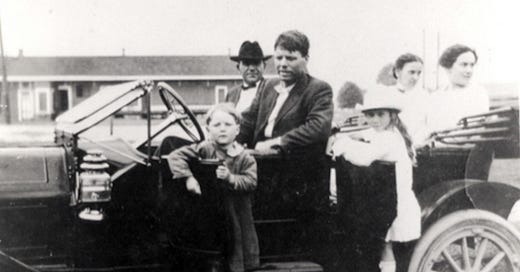Occasionally I’d like to take a look back at true crime texts, particularly podcasts, that predate the adrenaline shot to the genre that was Serial, but were also experimenting productively with form and content. “The Ghost of Bobby Dunbar,” from venerable narrative audio-journalism titan This American Life, fits the bill for me. Premiering in 2008,1 the episode is an hour-long interview with Margaret Dunbar Cutright about her revisitation and reinvestigation of a crime from her family’s past: Her grandfather disappeared in Louisiana in 1912 at four years old and was found with a handyman in Mississippi eight months later. The kidnapping, trial, and claim from another woman that the child recovered by the Dunbars was actually her son Bruce, was national news and solidified into legend in Margaret’s family. What she found out, and how she uncovered it, I’ll leave for you to discover.2
What interests me about the episode are a few stylistic and structural choices that are largely incidental to the central mystery, but exhibit some elements of contemporary true crime that I find particularly productive and compelling.
What Not to Do
Because the case was of national interest for years, it generated contemporary true crime texts of its own. The episode opens with the 1927 ballad “Mystery of the Dunbar’s Child” by Richard “Rabbit” Brown, hearkening back to true crime’s origins in murder ballads.3 In addition to this largely factual4 song, the episode also includes examples of bad true crime, specifically, stories that vilified Julia Anderson, the woman who claimed that the “Bobby Dunbar” recovered in Mississippi was actually her son. Journalists claimed that she was a bad mother, that she was uneducated, and that she was “of loose morals” all because she was, you guessed it, poor. Part of the movement of the episode is Margaret realizing the unfairness of this portrayal, which drives her to learn more about (and thereby rehabilitate the reputation of) the woman who accused her family of kidnapping her grandfather and calling him Bobby. The inclusion of irresponsible and misogynistic true crime highlights the way this episode is different. It will not make assumptions about women based on class, and thereby arrive at a more authentic resolution.5
What is true crime anyway?
Ever since I read Aja Romano’s Vox piece on when and how a local story became “true crime,” I’ve been mulling over their definition of this transformation. They contend that inviting the public’s perspective and investigatory capacity into an investigation is when a story stops “being solely a hometown tragedy and enter[s] the annals of true crime fame.” This opening up of a story to “armchair sleuths” certainly occurred with Serial, as Reddit boards exploded with theories and accusations of widely varying believability, and more podcasts and docuseries were spawned. But “The Ghost of Bobby Dunbar” shows that this claiming of a crime by the public is not only an Age of Internet phenomenon. The episode details Margaret’s discovery of a letter to the editor from a writer who identifies only as “A Christian Woman” that lays out weaknesses in the Dunbar’s case and its coverage in the media. This armchair sleuth further propels Margaret’s archival investigation into the kidnapping and trial.
Can True Crime Heal?
Readers of my newsletter on Alice Sebold’s discredited memoir might remember that one of my takeaways is that making true crime texts part of a carceral project is inherently troubling, and “The Ghost of Bobby Dunbar” certainly contributes to that argument. However, I’m more interested in Margaret’s motivation for looking into this crime and her history when she did. In 1999, she lost her brother in a plane crash. Months afterward, perhaps to distract her from her grief, her father gave her the scrapbook about her grandfather’s case that propelled her investigation. Margaret’s connection to the case is personal, authentic, and motivated by a desire to uncover a deeper truth, not to indict or punish. The repercussions of her choice to ask questions about a story that literally and figuratively structured her family were out of her control,6 but the result is a version of history that is a more complicated, and more truthful, story. At its best, this is what true crime can do.
The first episode of Serial premiered in October of 2014, yes nearly ten years ago, and yes I feel very very old.
Seriously, give it a listen this weekend. It’s an incredibly enthralling piece of audio storytelling: I missed my stop on the bus listening.
Shoutout forever and always to Brock Wilbur’s tweet arguing that Bob Dylan’s “Hurricane” is the first true crime podcast.
Though it does make an argument at the end.
I’m sort of fascinated by the inclusion of a text that is a bad version of the genre for means of comparison—The Sun Also Rises does this by including long passages of purple prose from a fictional novel to foreground, and endorse, Hemingway’s terse style.
And by no means entirely positive.




